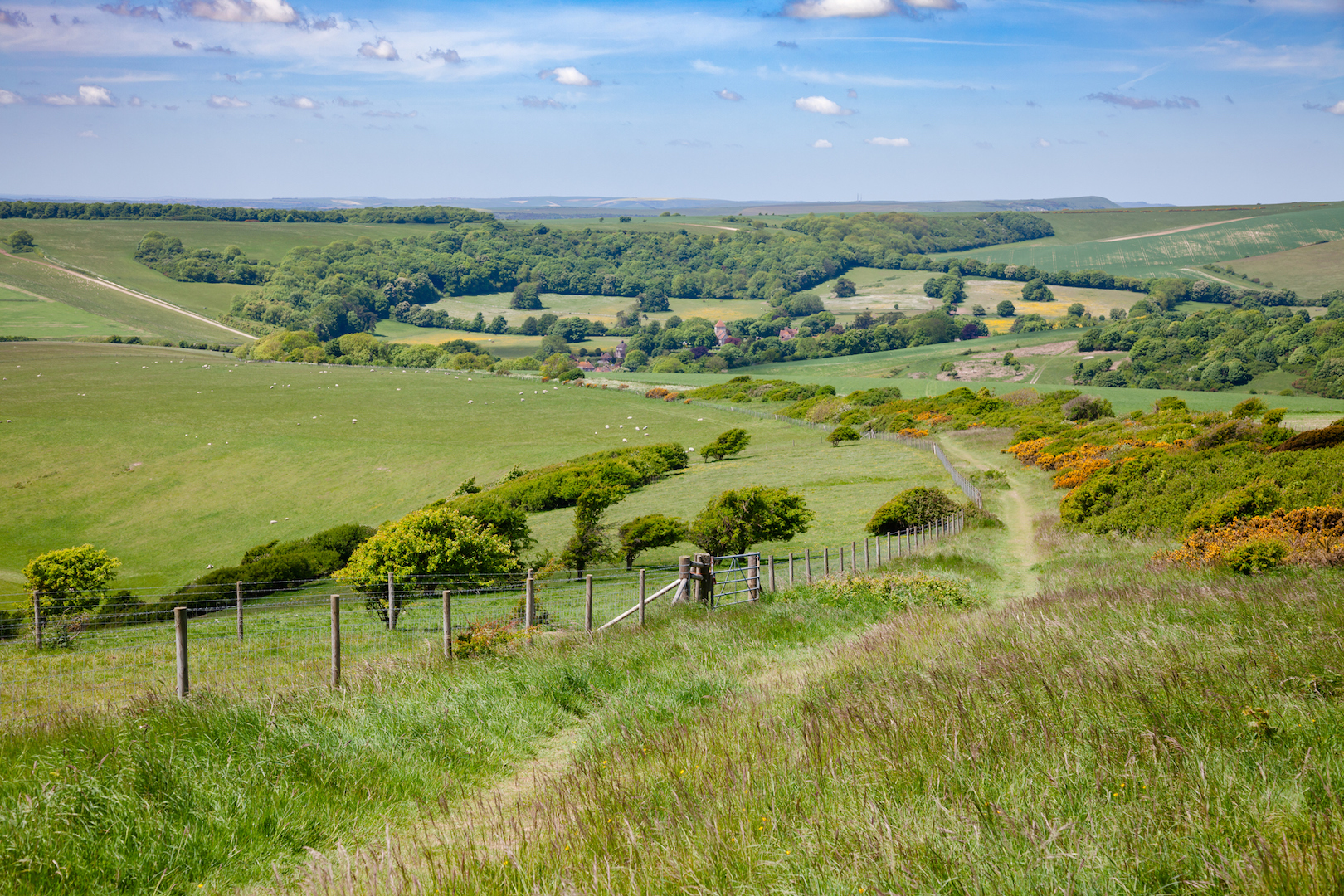The eighteenth-century writer Samuel Johnson famously said: ‘When a man is tired of London, he is tired of life’. Well, maybe – but even the most ardent lovers of city life feel the need to escape it once in a while, and Dr Johnson himself was no exception. Fortunately, there are some stunning walks within easy reach of England’s capital, and since travel is considerably quicker now than it was back in Johnson’s day, most of them can be reached in an hour or less. So, whether you hop in a car and head for the coast or jump on a train bound for the leafier parts of the home counties, we proudly present ten of the best walks near London. There’s plenty to go at too. From easy countryside rambles to more strenuous and challenging hill walks, the South East of England boasts a far greater variety of trails and landscapes than you might think.
As part of our latest collaboration with route planning app komoot to help them champion some of the best walking routes in the UK, we’ve whittled down our top 10 favourites within easy reach of London by car, train or bus. Of course, if you’ve got a little more time on your hands, then you might want to consider roaming farther afield and heading to South Wales for our Best Walks in the Brecon Beacons or even our guide to wild camping in the Brecon Beacons.
New to komoot? For a free regional bundle (worth £8.99) simply follow this link to komoot.com and create your free account today.
Best Walks Near London: The Top 10
- Leith Hill, Surrey Hills (Surrey)
- Ditchling Beacon and Jack & Jill windmills, South Downs (East Sussex)
- Bewl Water from Wadhurst station via Three Legs Cross (High Weald, Kent/Sussex border)
- London Loop – Cockfosters to Enfield Lock (Greater London)
- Margate to Ramsgate via Botany Bay (Kent coast)
- Chiltern Hills from Wendover (Buckinghamshire)
- Otford to Ainsford on the North Downs Way (Kent)
- Henley-on-Thames to Tilehurst on the Thames Path National Trail (Oxfordshire)
- Epping Forest (Essex/Greater London borders)
- The Pilgrim’s Way (Hampshire, Surrey and Kent)
Walk 1: Climb Up To South East England’s Highest Point
Pick any walk in the Surrey Hills and you’ll soon see why they fully merit their ‘area of outstanding natural beauty’ status. However, this route showcases a particularly stunning slice of the local landscape, taking you along stretches of the Greensand Way before climbing up Leith Hill to reach the striking 18th century Gothic Leith Hill Tower. Climb the stairs to the top of the tower and you’ll be at the highest point in South East England, with far reaching views all the way back to London. You might even spot the distinctive landmark that is the London Eye or, further north, the swooping arch of Wembley Stadium. The route then takes you down through woodland to the sleepy hamlet of Friday Street, before walking through wooded Abinger Common and Pasture Wood to return to Holmbury-St-Mary, where the Royal Oak Pub often has a roaring fire ready to welcome weary walkers.
Matt Says: “I spent fifteen long years living and working in London, and the Surrey Hills was a regular and very welcome weekend escape from the city. This route is a particular gem.”
Walk 2: Visit A Working Windmill On The Spectacular South Downs
The Iron Age hillfort of Ditchling Beacon is one of the highest points on the South Downs, with spectacular views out over chalk grassland. A walk along the lofty ridge brings you to the picturesque 19th century Jack and Jill windmills, which perch atop the downs. You’ll enjoy their charm and the setting, looking out across the pretty Sussex Weald. The next highlight on the route is the atmospheric Chattri, a memorial to Indian soldiers who died between 1914 and 1918. From here you’ll roam the hills of the downs, gently undulating your way back to the start point.
Matt Says: “Jack is privately owned, but Jill is a traditional working corn windmill, whose doors are sometimes open to visitors, and if the conditions are right, might even be milling local Sussex wheat to make stoneground wholegrain flour.”
Walk 3: Take A Waterside Wander Around Beautiful Bewl Water
Bewl Water is not to be missed. This vast reservoir, which holds 31 million litres of water, is the largest inland body of water in the South East of England and offers up a varied circular walk along forest paths and down country lanes. The scenery is beautiful and you’ll often have long stretches all to yourself. Various sections of the route hug the lake shore, giving plenty of opportunity to find a picturesque spot for a rest and to dip your toes in the cold water.
Matt Says: “Whatever you do, don’t visit the Bull Inn at the start of this route, because it’s far too easy to get waylaid by its inviting armchairs, roaring open fire and delicious pub grub. Save it for the end instead. You won’t regret it. In fact, this is probably my favourite Kent pub – and as a Man of Kent, I’ve been to a fair few!”
Walk 4: Soak Up Centuries Of History On The London Loop
This walk from Cockfosters to Enfield Lock is chock-full of history. You’ll pass Trent Park, once the home of the Sassoon family, later requisitioned by the government to become an interrogation and bugging centre for captured military personnel during the Second World War. You’ll stroll through Enfield Chase, a 12th century royal hunting forest, and pass the Camlet Moat, a small island that was thought to have been the seat of Geoffrey de Mandeville during the reign of William the Conqueror. The Jubilee Path will lead you through a working farm estate, before walking through the beautiful Hilly Fields Park, which was once home to the many glasshouses that produced tomatoes and cucumbers for the nation. The Grade 1 listed Forty Hall is another highlight along the route and is said to be where Sir Walter Raleigh spread his cloak over a puddle to spare Queen Elizabeth I from getting wet feet. You’ll leave the greenery behind as you head down Turkey Street, picking up Turkey Brook to the finish point at Enfield Lock.
Matt Says: “As its name suggests, the London Loop is a giant circular circumnavigation of London that has been described as the ‘M25 for walkers’. While some sections are very urban, others are surprisingly rural, like this tranquil stretch.”
Walk 5: Walk ‘The Nose Of Kent’ To Visit Chalk Stacks And Rock Pools
On a map of Kent, the Isle of Thanet protrudes like a nose, pointing towards France and the Low Countries. In the past it was separated from the mainland by the Wantsum Channel. Although it is no longer an island, it still boasts some fabulous coastline, including the sections that link the three historic coastal towns of Margate, Broadstairs and Ramsgate. It’s a great option for anyone travelling by train, as there’s a station at either end with frequent trains to and from London. The route broadly follows the Viking Coastal Trail, taking you along low chalk cliffs, with dramatic, sweeping views out across the channel, or along stretches of promenade. The real highlight of the route is Botany Bay, a sandy cove with impressive chalk stacks and rock pools. Try and time your visit for low tide, so you can really explore this gem. If you look hard enough, you might even find a fossil.
Matt Says: “I don’t know if anyone else calls Thanet the nose of Kent, but it’s how I’ve always thought of it. Threading your way through the chalk stacks at Botany Bay is a unique experience and it’s the reason why this is one of my favourite coast walks.”







